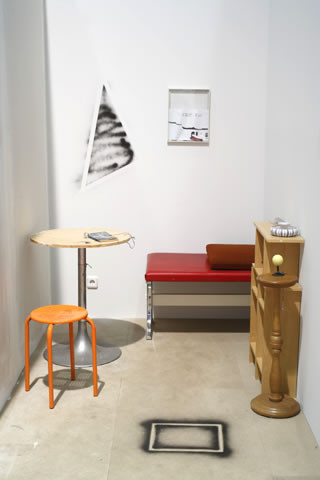Manfred Pernice
26 Nov 2010 - 13 Feb 2011

Manfred Pernice, Sonderausstellung (wishi-washy), Art Unlimited, Basel 2009 (Detail), Photo: Simon Vogel, Courtesy: Galerie Neu, Manfred Pernice
MANFRED PERNICE
26 November, 2010 – 13 February, 2011
Manfred Pernice’s sculptural works are built or assembled out of simple materials such as cardboard, chipboard, concrete, and metal, to which he adds texts, maps, and photocopies. In spite of their makeshift character, there is much in these open sculptures that recalls the formal precision of architectural models, figures, furniture, and other everyday objects.
Taking observations of the urban environment as his point of departure, Pernice highlights the inadequacies of this environment and subjects the ordering systems of modernity to a fundamental critique. To explain his specific artistic approach to these systems, he has introduced concepts such as Verdosung (canning) and Peilung (linking). The former involves isolating and preserving specific information stored in the workings of the present: original use of language, function, architectural form, and immanent norms. For the latter, Pernice connects specific places or representations of them to form complex, richly associative structures. Starting from one position, he creates a weave of spatial axes, relationships, and material references, as well as showing an increasing interest in their disintegrative potential. In this way, his works are able to develop both an autonomous form and a character that is installation-based, narrative, and site-specific.
Manfred Pernice (born 1963) lives and works in Berlin.
26 November, 2010 – 13 February, 2011
Manfred Pernice’s sculptural works are built or assembled out of simple materials such as cardboard, chipboard, concrete, and metal, to which he adds texts, maps, and photocopies. In spite of their makeshift character, there is much in these open sculptures that recalls the formal precision of architectural models, figures, furniture, and other everyday objects.
Taking observations of the urban environment as his point of departure, Pernice highlights the inadequacies of this environment and subjects the ordering systems of modernity to a fundamental critique. To explain his specific artistic approach to these systems, he has introduced concepts such as Verdosung (canning) and Peilung (linking). The former involves isolating and preserving specific information stored in the workings of the present: original use of language, function, architectural form, and immanent norms. For the latter, Pernice connects specific places or representations of them to form complex, richly associative structures. Starting from one position, he creates a weave of spatial axes, relationships, and material references, as well as showing an increasing interest in their disintegrative potential. In this way, his works are able to develop both an autonomous form and a character that is installation-based, narrative, and site-specific.
Manfred Pernice (born 1963) lives and works in Berlin.
